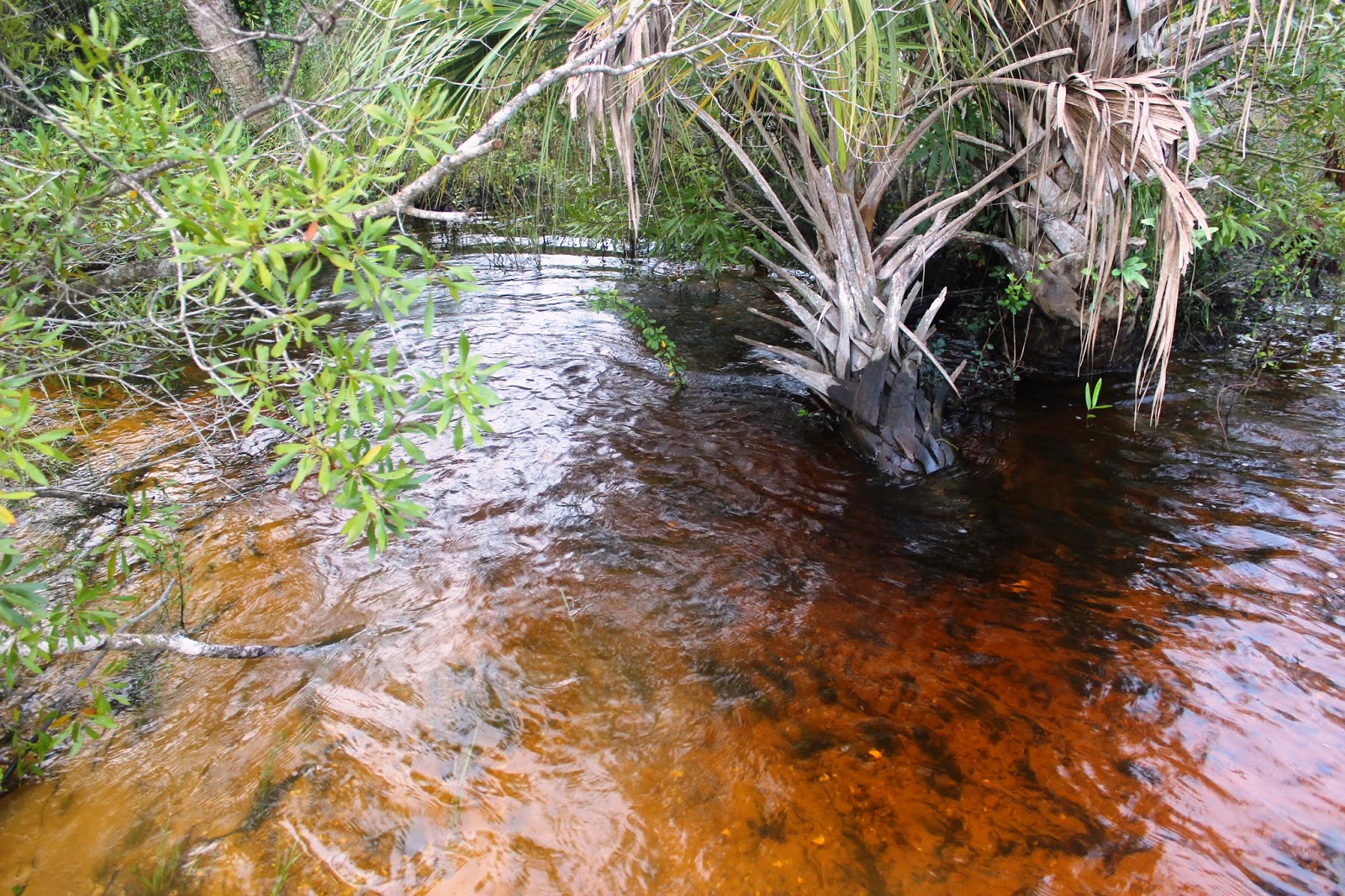“There’s one” Dan exclaimed, quickly raising his rifle to
his shoulder. I barely had time to react when the rifle cracked like thunder. I
was able to catch a glimpse of the big hog just as he fell over.
We were hunting on Babcock Ranch Preserve, part of the
Crescent B Ranch. The Preserve consists of over 70 thousand acres in Charlotte
and Lee Counties and it represents one of the largest single purchases of
conservation land in the state's history. The area protects incredibly diverse
natural habitats, important water resources and scenic landscapes in the quickly
growing southwest Florida area. Portions of the Preserve are under hunting
lease agreements, and we were on Dan’s family lease. I was fortunate to be
invited for a day of hunting and fishing in one of Florida’s best known and
most pristine wilderness areas.

We arrived early the evening before, driving on partially
submerged trails for miles from any asphalt covered roadways. These trails lead
through open pastures, pine canopies shading palmetto and cypress lined creeks
and ponds. This is a working cattle ranch and we drove past herds of cows being
worked by real-life cowboys. This is the real old Florida, from the days of
cattle barons and homesteaders.
The camp consisted of an older cabin situated on the banks
of Clay Gully. Permanent buildings are not allowed, but the cabin was an
existing structure from an earlier era, meticulously restored by Dan’s
Father-in-law, Bruce. The remarkably quiet generators supplied enough
electricity to provide air-conditioning and lighting which was a nice surprise
given the remoteness of the camp and the residual heat left over from a hot
summer day. After dinner, we fished in the creek for a while and caught some of
the most beautiful bluegill I have ever seen.



After a fitful sleep, I awoke to fresh coffee and breakfast.
In the inky pre-dawn darkness, we loaded up the camp jeep for the ride into
even more remote areas to find our quarry. As our headlights scanned the trail
before us, we spied raccoons, possums and deer scampering into the brush. After
going through a couple cattle gates, we approached the boundary of the lease,
Dan turned onto a submerged trail and the older but very capable camp jeep came
to a sudden stop. Flashlight in hand, Dan surveyed the scene and found the
problem. “Looks like we threw a wheel bearing. It’s on foot from here”. We made
the best of what could've been a ruined trip and hunted our way back to the
safe haven of camp. We had quite the trek ahead of us, with rifles slung, day
packs stocked with water and jerky. This ended up playing to our advantage.
Without the rumble of the engine and creaking of the jeep, we were able to pick
up the subtleties of tracking. Turkey, deer, raccoon, hogs and alligator tracks
were seen during our journey back to Dan's pickup at camp.


Since 1914, the Crescent B Ranch has produced timber,
cattle, crops, and sod, and provided recreation opportunities such as hunting
and ecotourism. The area is so vast that
much of it remained untouched and natural. During the sale of the property in
2006, a portion of the original ranch was reserved for a private residential
development known as the Babcock Ranch Community and the remainder was sold to
the state. The Preserve is managed by a unique public-private partnership which
helps maintain the property as a working ranch with hunting and eco-tourism
operations. Revenue from these activities provides the resources necessary to
maintain and protect the property for the citizens of Florida.


We had been walking
the trail for a short time. The sun had come up over a nearby prairie flooding
the wooded edge with light. “There’s one” Dan exclaimed, quickly raising his
rifle to his shoulder. I barely had time to react when the rifle cracked like
thunder. I was able to catch a glimpse of the big hog just as he fell over.
There were a few others that scattered into the woods in response to the
gunshot. Dan took off across the field, closing the gap in short order. It was
a good hog, certainly big and meaty enough for a few family barbeques. A short
foray into the woods confirmed the rest of the group was long gone. Dan field
dressed the hog and we completed the long hike back to camp.


A couple hours later we were headed to a fishing pond on the
lease. We stopped by the camp jeep to partially dismantle the front end for
replacing later. Turns out we spun a hub as well. As we journeyed to the
fishing spot, Dan explained there are a few on the property, and his family has
landed bass up to 12 pounds. Not hard to believe when you see the deep, clear
borrow pits and plethora of baitfish on the surface. Little fishing pressure
means the fish are receptive to our artificial bait. Within minutes, drag was
peeling line from my reel. The bass wasn’t huge, but it was fat and healthy.
Bass elsewhere in Florida can sometimes be a little thin, but these fish are
dense and heavy for their size and great fighters as well.



We rounded out the day with a photo safari. I didn’t want to
keep Dan much longer from getting the camp jeep back in order. We drove through
mainly forested areas, stopping to take photos of whatever looked good. Along
the way we saw deer, Osceola turkey, quail and even some crayfish, which Dan
says taste like little lobsters. I will take his word on that. Born and raised in
Florida, Dan’s excitement and love of the area was evident. “Within a three
hour drive from here, you can engage in world-class off shore fishing, inshore
fishing, freshwater fishing and hunting”. Indeed he is correct, which is why
Florida, and particularly places like Babcock Ranch Preserve, remains a
sportsman’s paradise.






































